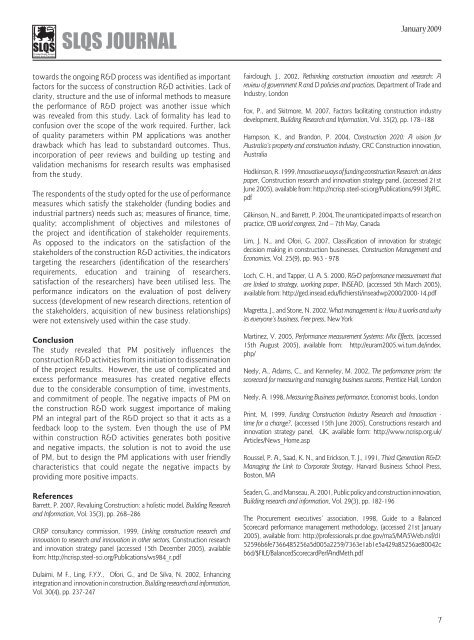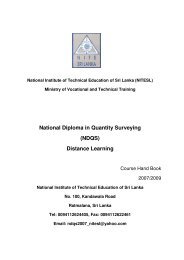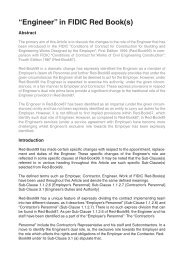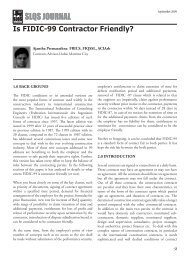SLQS-Journal Vol. 1 - Slqs-uae.org
SLQS-Journal Vol. 1 - Slqs-uae.org
SLQS-Journal Vol. 1 - Slqs-uae.org
Create successful ePaper yourself
Turn your PDF publications into a flip-book with our unique Google optimized e-Paper software.
<strong>SLQS</strong> JOURNALJanuary 2009towards the ongoing R&D process was identified as importantfactors for the success of construction R&D activities. Lack ofclarity, structure and the use of informal methods to measurethe performance of R&D project was another issue whichwas revealed from this study. Lack of formality has lead toconfusion over the scope of the work required. Further, lackof quality parameters within PM applications was anotherdrawback which has lead to substandard outcomes. Thus,incorporation of peer reviews and building up testing andvalidation mechanisms for research results was emphasisedfrom the study.The respondents of the study opted for the use of performancemeasures which satisfy the stakeholder (funding bodies andindustrial partners) needs such as; measures of finance, time,quality; accomplishment of objectives and milestones ofthe project and identification of stakeholder requirements.As opposed to the indicators on the satisfaction of thestakeholders of the construction R&D activities, the indicatorstargeting the researchers (identification of the researchers’requirements, education and training of researchers,satisfaction of the researchers) have been utilised less. Theperformance indicators on the evaluation of post deliverysuccess (development of new research directions, retention ofthe stakeholders, acquisition of new business relationships)were not extensively used within the case study.ConclusionThe study revealed that PM positively influences theconstruction R&D activities from its initiation to disseminationof the project results. However, the use of complicated andexcess performance measures has created negative effectsdue to the considerable consumption of time, investments,and commitment of people. The negative impacts of PM onthe construction R&D work suggest importance of makingPM an integral part of the R&D project so that it acts as afeedback loop to the system. Even though the use of PMwithin construction R&D activities generates both positiveand negative impacts, the solution is not to avoid the useof PM, but to design the PM applications with user friendlycharacteristics that could negate the negative impacts byproviding more positive impacts.ReferencesBarrett, P. 2007, Revaluing Construction: a holistic model, Building Researchand Information, <strong>Vol</strong>. 35(3), pp. 268–286CRISP consultancy commission, 1999, Linking construction research andinnovation to research and innovation in other sectors, Construction researchand innovation strategy panel (accessed 15th December 2005), availablefrom: http://ncrisp.steel-sci.<strong>org</strong>/Publications/ws984_r.pdfFairclough, J., 2002, Rethinking construction innovation and research: Areview of government R and D policies and practices, Department of Trade andIndustry, LondonFox, P., and Skitmore, M. 2007, Factors facilitating construction industrydevelopment, Building Research and Information, <strong>Vol</strong>. 35(2), pp. 178–188Hampson, K., and Brandon, P. 2004, Construction 2020: A vision forAustralia’s property and construction industry, CRC Construction innovation,AustraliaHodkinson, R. 1999, Innovative ways of funding construction Research: an ideaspaper, Construction research and innovation strategy panel, (accessed 21stJune 2005), available from: http://ncrisp.steel-sci.<strong>org</strong>/Publications/9913fpRC.pdfGilkinson, N., and Barrett, P. 2004, The unanticipated impacts of research onpractice, CIB world congress, 2nd – 7th May, CanadaLim, J. N., and Ofori, G. 2007, Classification of innovation for strategicdecision making in construction businesses, Construction Management andEconomics, <strong>Vol</strong>. 25(9), pp. 963 - 978Loch, C. H., and Tapper, U. A. S. 2000, R&D performance measurement thatare linked to strategy, working paper, INSEAD, (accessed 5th March 2005),available from: http://ged.insead.edu/fichiersti/inseadwp2000/2000-14.pdfMagretta, J., and Stone, N. 2002, What management is: How it works and whyits everyone’s business, Free press, New YorkMartinez, V. 2005, Performance measurement Systems: Mix Effects, (accessed15th August 2005), available from: http://euram2005.wi.tum.de/index.php/Neely, A., Adams, C., and Kennerley, M. 2002, The performance prism: thescorecard for measuring and managing business success, Prentice Hall, LondonNeely, A. 1998, Measuring Business performance, Economist books, LondonPrint, M, 1999, Funding Construction Industry Research and Innovation -time for a change?, (accessed 15th June 2005), Constructions research andinnovation strategy panel, UK, available form: http://www.ncrisp.<strong>org</strong>.uk/Articles/News_Home.aspRoussel, P. A., Saad, K. N., and Erickson, T. J., 1991, Third Generation R&D:Managing the Link to Corporate Strategy, Harvard Business School Press,Boston, MASeaden, G., and Manseau, A. 2001, Public policy and construction innovation,Building research and information, <strong>Vol</strong>. 29(3), pp. 182-196The Procurement executives’ association, 1998, Guide to a BalancedScorecard performance management methodology, (accessed 21st January2005), available from: http://professionals.pr.doe.gov/ma5/MA5Web.nsf/d152596b6fe7366485256a5d005a2259/7363e1ab1e5a429a85256ae80042cb6d/$FILE/BalancedScorecardPerfAndMeth.pdfDulaimi, M F., Ling, F.Y.Y., Ofori, G., and De Silva, N. 2002, Enhancingintegration and innovation in construction, Building research and information,<strong>Vol</strong>. 30(4), pp. 237-2477





